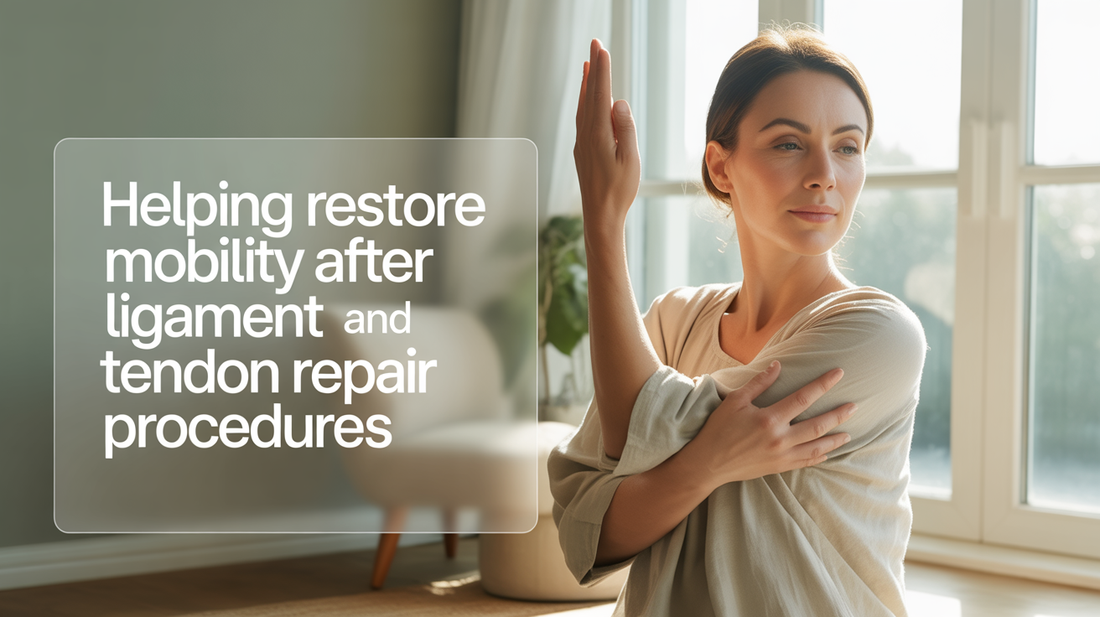
Helping Restore Mobility After Ligament and Tendon Repair Procedures
Share
When recovering from ligament and tendon repair, mobility restoration is one of the most important goals. These procedures often follow injuries or degenerative conditions that significantly impact daily movement and quality of life. The healing process involves not only physical recovery but also the right strategies to ensure long-term functionality and strength.
Why Restoring Mobility Matters
Ligaments and tendons play vital roles in stabilizing joints and enabling movement. Damage to these tissues can restrict mobility, cause pain, and increase the risk of further injury. After surgical repair, targeted mobility restoration:
✅ Supports joint stability and balance.
✅ Prevents stiffness and scar tissue formation.
✅ Encourages proper muscle re-engagement.
✅ Reduces the likelihood of reinjury.
Key Benefits of Mobility Restoration
Here are some benefits of mobility restoration:
1. Faster Functional Recovery
Early mobilization helps patients return to normal activities more quickly by preventing long-term stiffness. It also shortens the overall rehabilitation timeline, enabling individuals to regain independence in daily tasks such as walking, climbing stairs, or driving sooner. Patients who embrace early movement strategies often report higher satisfaction with their recovery process.
2. Improved Range of Motion
Targeted movement ensures that repaired tissues heal without excessive tightening, maintaining flexibility. As flexibility improves, patients experience better posture, more natural gait patterns, and reduced compensatory movements that could otherwise strain other joints or muscles. Consistent stretching routines further safeguard against long-term limitations.
3. Pain Reduction
Gentle mobility exercises can reduce inflammation and improve circulation, leading to less pain during recovery. Better circulation delivers oxygen and nutrients to healing tissues, accelerating the body’s natural repair process. This decrease in pain makes it easier for patients to participate in physical therapy, creating a positive cycle of progress.
4. Strength Reinforcement
Progressive loading of ligaments and tendons encourages collagen alignment, building stronger, more resilient tissues. Over time, these tissues adapt to handle greater stress, reducing vulnerability to future injuries. Strengthening exercises also support surrounding muscles, providing a stable foundation that allows repaired tissues to function more effectively during everyday activities and athletic performance.
Effective Mobility Support Approaches
There are several proven strategies that can aid the process of regaining mobility after ligament and tendon repair. Each approach plays a complementary role in supporting healing and restoring function. In many cases, combining several of these approaches leads to the best outcomes, as the body benefits from multiple forms of support simultaneously:
Rehabilitation Exercises: Tailored physical therapy programs often include stretching, controlled weight-bearing, and low-resistance training to gradually restore movement. Over time, these programs may advance to incorporate balance drills, resistance equipment, and task-specific movements that replicate daily activities, ensuring a smoother transition back to normal life.
Assistive Therapies: Techniques such as hydrotherapy, massage, or electrical stimulation can support mobility gains. Hydrotherapy, for example, reduces joint stress by using water’s buoyancy, while massage helps improve blood flow and reduce muscle tension. Electrical stimulation can enhance muscle activation, particularly in patients who initially struggle with voluntary muscle control.
Innovative Delivery Systems: Supplementation options—like oral strips—may provide nutrients that support tissue repair and reduce inflammation, making mobility exercises easier and more effective. These delivery systems are convenient, discreet, and designed to complement physical therapy by aiding recovery at the cellular level.
Lifestyle Adjustments: Maintaining a healthy weight, focusing on balanced nutrition, and practicing consistent low-impact activity all contribute to long-term mobility. Adding habits such as adequate hydration, proper sleep, and stress management can further accelerate healing, while mindful movement practices like yoga or tai chi help sustain flexibility and coordination for the long term.
Comparison at a Glance
| Feature | Early Rehab Phase | Mid Rehab Phase | Long-Term Phase |
|---|---|---|---|
| Focus | Pain control & gentle movement | Strength & flexibility | Functional independence |
| Exercise Type | Passive stretches, assisted range of motion | Resistance bands, balance drills | Full activity, sport-specific training |
| Key Benefit | Prevents stiffness | Builds resilience | Restores full mobility |
Key Takeaway: Mobility restoration is a progressive journey, beginning with gentle movements and advancing toward full functional recovery.
Practical Considerations
Here are some Practical Considerations that can significantly influence the success of recovery and long-term outcomes:
- Patience is Crucial: Overloading repaired tissues too soon can hinder recovery. Progress must be gradual, as connective tissues need sufficient time to heal and adapt. Attempting to rush the process can result in setbacks or even reinjury that prolongs recovery.
- Consistency Matters: Regular movement, even in small doses, prevents regression. Small daily exercises, posture adjustments, and mindful stretching help sustain progress between therapy sessions, reinforcing the body’s learning and avoiding stiffness.
- Professional Guidance: Physiotherapists and orthopedic specialists provide customized plans to optimize outcomes. Their expertise ensures that exercises are safe, progressive, and tailored to individual conditions, reducing the risk of complications.
- Environment and Support: A safe, accessible home or workplace environment—free of trip hazards and equipped with supportive tools like braces or walking aids—makes following rehab routines easier and lowers the chance of accidents.
- Holistic Health Factors: Adequate nutrition, hydration, sleep, and stress management all play roles in tissue repair and energy levels. Addressing these factors boosts recovery speed and supports long-term mobility resilience.
Final Word
Restoring mobility after ligament and tendon repair requires a balance of structured rehabilitation, supportive therapies, and lifestyle adjustments. With a patient-focused approach, individuals can achieve stronger, more flexible tissues and return to the activities they love with renewed confidence.
